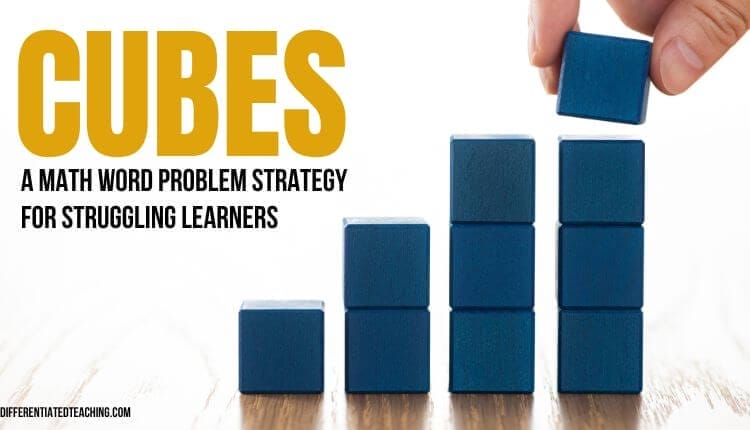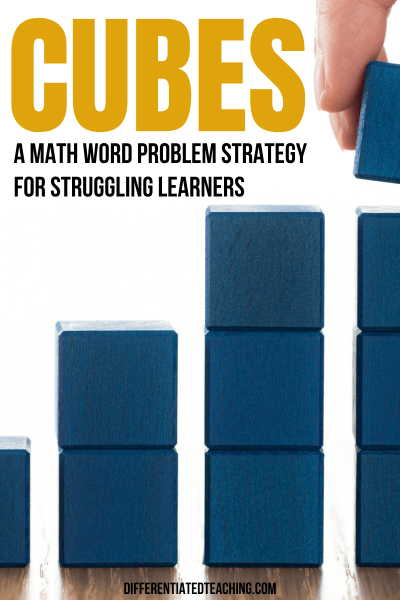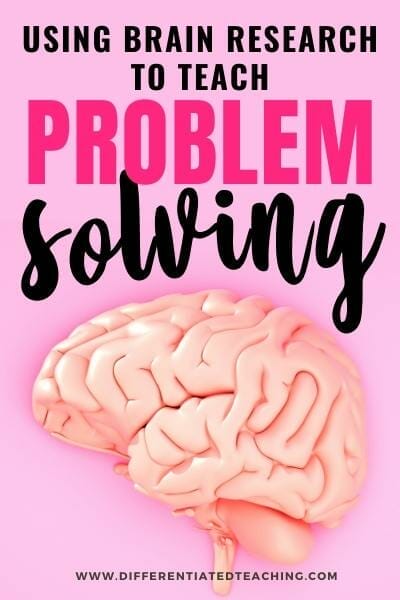Exploring the Power of the CUBES Math Strategy for Word Problems
Math problem-solving is one of the most challenging things we teach. The CUBES strategy is all about helping students tackle those tricky word problems with ease. Whether you’re dealing with pesky volume or area questions, or trying to figure out how many more apples Sally has than Timmy, the CUBES math strategy can be a great way to help those learners who struggle with word problems develop a systematic method to approach these problems. By breaking down the problem into smaller, more manageable chunks, you can quickly solve even the most complicated math problems.
So if you’ve ever found yourself scratching your head in frustration over your struggling learners’ battle with story problems, fear not! The CUBES math strategy is here to make your life a whole lot easier. Stick around to learn more about how this awesome strategy can help you help your struggling students become math problem-solving pros!
What is the CUBES Math Strategy?
The CUBES math strategy is a tool designed to help give students a systematic approach to breaking down and solving math word problems. The acronym C.U.B.E.S stands for:
- Circle key numbers & units
- Underline the question
- Box math action words
- Evaluate the problem
- Solve the problem & check your work
By breaking down the problem into these steps, students can better understand the context of the problem and effectively solve it.
Benefits of using the CUBES strategy in math word problems
While CUBES is not the ideal method for all math problem solving, especially as word problems become more complex, you can use the strategy as a starting point to guide struggling students in being more attentive and systematic when tackling word problems.
Many struggling learners struggle with executive functioning and need a clear-cut plan for tackling this next-level math skill, and incorporating a strategy like CUBES into your teaching can give them steps to approach word problems rather than leaving them overwhelmed and unsure where to begin. This can help students build confidence in their ability to successfully solve math story problems and prepare them to solve multi-step problems, ultimately enhancing their problem-solving skills.
Step-by-Step Guide to Using the CUBES Strategy
Implementing the CUBES strategy means teaching students the key steps and working through a gradual release process until they can effectively do this themselves. This systematic approach helps students understand the problem and empowers them to tackle word problems with confidence. Here’s a little more about each step your students will need to achieve:
C- Circle the numbers & units
C stands for “circle the key information.” This includes the numbers, units, and core information needed to solve the problem. This includes identifying math vocabulary that represents a number, such as “several,” “half,” or “a dozen.” Some questions may not involve numbers at all, in which case you would circle each instance of the word “none.” It is also important to identify units (such as feet, miles, or kilograms) and whether there is a decimal point.
While we don’t want students solely relying on keywords when faced with a word problem, it can be helpful for them to recognize which words are references to mathematical symbols. For example, “+” means addition, and “-” means subtraction.
U- Underline the question
After students read the problem and circle numbers/units, they must underline the question. While this may seem silly, if students aren’t attending to what is being asked, they won’t get the right answer. Helping students stay on target is a key component of the CUBES strategy for solving math problems.
Once your student has underlined the question and knows exactly what he or she needs to solve, it’s time to move on to step B: boxes and bullets.
B- Box math action words
Notice this doesn’t say keywords…Again, we don’t want students focused solely on using keywords for math problem solving. Research has shown time and time again this is an ineffective strategy once problems become more complex.
That said, students need to look at word problems through the lens of critical readers. What in the problem gives them a clue as to what they need to do to solve it?
Just like the author of a story gives us details to help us infer and get to the story’s resolution, the author of a word problem helps us find the path to the solution. We need to be critical readers to get there. This is where boxing key information can be helpful. Here are some common examples that are often viewed as keywords but are critical for students to attend to to solve problems accurately:
- Addition: add, added, both, sum, total
- Subtraction: difference between, less than
- Multiplication: times twice as many/much as of every
- Division: split equally among/between each share out of
E- Evaluate or Equation
At this stage, it’s time to implement your strategy to solve. For some students, this will be writing and solving the equation. Others may need to evaluate by drawing a picture or using manipulatives to model the problem.
Either way, by this stage your learners should have broken down the problem to the point that they feel confident implementing a method that will lead them to the final step – solving.
S- Solve & Check
Once the strategy has been chosen, guide your students through the process of solving the problem. This may involve writing out the equation, solving for the unknown variable, and checking their work to ensure they have found the correct solution.
Encourage your students to show their work and explain their reasoning as they solve the problem. This will not only help them understand the process better but also allow you to provide feedback and support if needed.
It’s important to emphasize the importance of checking their work to ensure they have found the correct solution. This may involve plugging the solution back into the original problem to verify it or checking their work for errors in calculations.
Once your students have successfully solved the problem, congratulate them on their hard work and encourage them to reflect on the process. Ask them questions such as what strategies worked well for them, what challenges they encountered, and how they can apply what they have learned to similar problems in the future.
By guiding your students through the process of problem-solving and encouraging them to reflect on their work, you are helping them develop essential critical thinking skills that will serve them well in all areas of their education and beyond.

Tips for Implementing the CUBES Math Word Problem Strategy
Whenever you’re preparing to implement a strategy with your struggling learners, it can be helpful to get some tips from teachers who have been there. In asking for advice from colleagues, here’s what they had to say.
To teach the cubes strategy, you should:
- Teach the strategy as a whole. Because this is such a visual strategy, it’s useful to provide multiple examples of how to solve problems with CUBES on a poster or anchor chart. You can use the chart below as an example of what to include.
- Use a standard problem as an example. Before having students practice on their own, have them watch and listen as you model how to use the CUBES strategy on the board using a Problem of the Day or by writing in student journals. Visual learners will appreciate watching you write out each step and manipulate your complex number sentence cube.
- Use anchor charts you make together in class. Then transfer that knowledge into modeling one or two more examples with students using cubes they create out of construction paper, or if necessary, manipulatives like buttons or dry beans.
- Don’t fall into the trap that the standard algorithm is the only way to solve once the strategy has been used. Let students draw pictures, use manipulatives, make number lines, or whatever other strategies you’ve taught. The CUBES math strategy is to help them break up the problem. It isn’t the guiding principle of the math calculations.
- Students can use CUBES to filter out irrelevant details and focus on the essential details needed to solve the problem. By guiding students to evaluate the problem systematically, you can help students make informed decisions and tackle complex math challenges. It is great for learners who might get bogged down in all the details.









